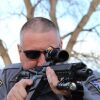When we think of SWAT, we think of the best cops a department has to offer. SWAT guys and gals must be the best shooters, the best decision-makers and the most physically fit folks in law enforcement.
I don’t claim to be an expert on fitness or even someone who is exceptionally fit. I do, however, know what I had to work on when I got on my department’s team. There are a few things tactical teams need to focus on and it isn’t what I see a lot of cops doing in the gym. In fact, I know a lot of elements who consider themselves tactical teams who do not have physical standards at all. That’s a mistake.
Legs and shoulders
If you don’t have one in place already, appoint a member of the team as your fitness coordinator. You need someone who understands the work of a tactical team, a high level of fitness knowledge and how to make that knowledge work to keep the team as safe as possible.
Our team’s fitness coordinator has a degree in health promotion and played rugby for Oklahoma State University. He stresses the importance of focusing on legs and shoulders over the “glamour muscles” like pectorals and biceps. Our body armor is heavier than that of patrol. Then, we add extra magazines, NFDDs and all kinds of other gear to it just to ensure it’s an unenviable load on our legs and shoulders. The time we need to spend “holding a port” (watching a door with a long gun at the ready) might be a few hours. Strong legs and shoulders are golden during those times.
Joint health
Ask me how I know how important joint health is. Joint injuries are career killers. A proper warm-up can be the difference between a productive workout and a life-changing injury.
Treat warming up with the same regard as the rest of your exercise and health program. It’s that important. In fact, I would say it’s the most important anti-injury preventative health step you can take.
Core
Your core is your body’s figurative and literal center. Core work is imperative to systemic health. Abdominals, back and lateral obliques are critical to the systemic health and safety of SWAT cops. Your back is one of the most vulnerable parts of your body. Keeping a strong back is often an overlooked piece of fitness, just as is balance. Maintaining a strong back is dangerous without balancing abdominal muscles. Likewise with the all-important triceps and the need for a strong bicep for balance.
Cardio, cardio, cardio
If you don’t run, you aren’t fit for SWAT. I’m sorry, but that’s true. There is no other way to achieve the necessary stamina, stress inoculation and resilience required for SWAT. I’m certain there are those who would argue, but my experience tells me running is the king of cardio.
I had a few of our team members who feared running because of the potential for injury. There is a solution for that in the Chi Running technique. I suggest buying the book and teaching its principles to your team. Having been prone to shin splints and even suffering a stress fracture, I can tell you this book is invaluable.
How
How do we accomplish this? Most SWAT teams are not full-time teams where they practice and work out every day. Most teams practice twice a month. As should all teams, ours has an annual test that must be successfully completed for a member to stay on the team. When I was the team administrator, we did that test at least monthly. There’s nothing like positive peer pressure to ensure compliance. No one wants to be embarrassed in front of their teammates.
The test
Your team should have an annual test as I mentioned above. Just as SWAT officers should be your department’s best shooters and decision-makers, they should also be the fittest. The only way to ensure that is through a test.
Ensure your test is job-relevant. For example, a pull-up may be a great way to show fitness but is it really something officers will be required to do on a callout? Dragging or carrying an officer or a civilian out of a bad place, however, certainly is. Consider those things when constructing your test.
Be fit or be gone
There is a temptation to loosen up the fitness standards to keep an aging, but invaluable, team member. I believe this is bad practice. When I blew up my shoulder, I was under doctor’s orders to avoid pushups for at least one year. As the guy who had been pushing fitness for years, I knew I had to resign from the team. It was devastating, but it was the only thing I could do. Every minute we spend in the gym or on the road might mean the difference between a successful mission and a tragedy. The team’s effectiveness is more important than one of its members.



